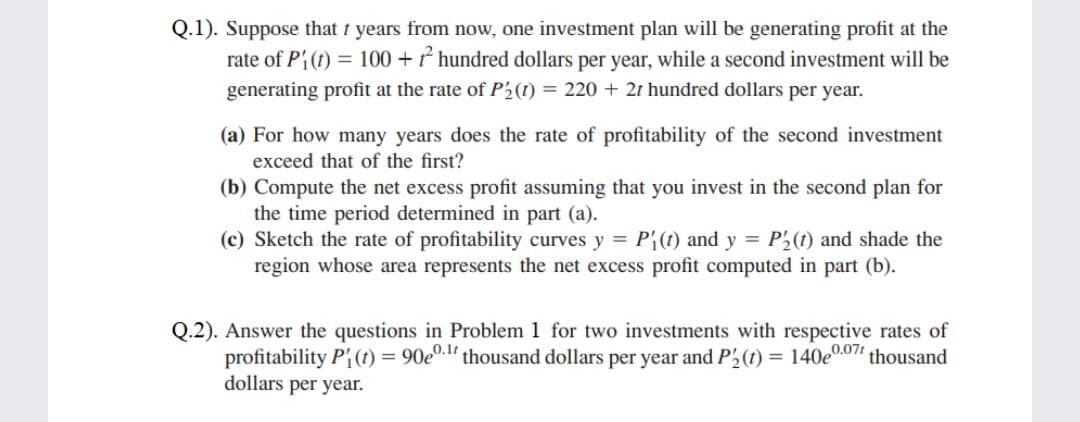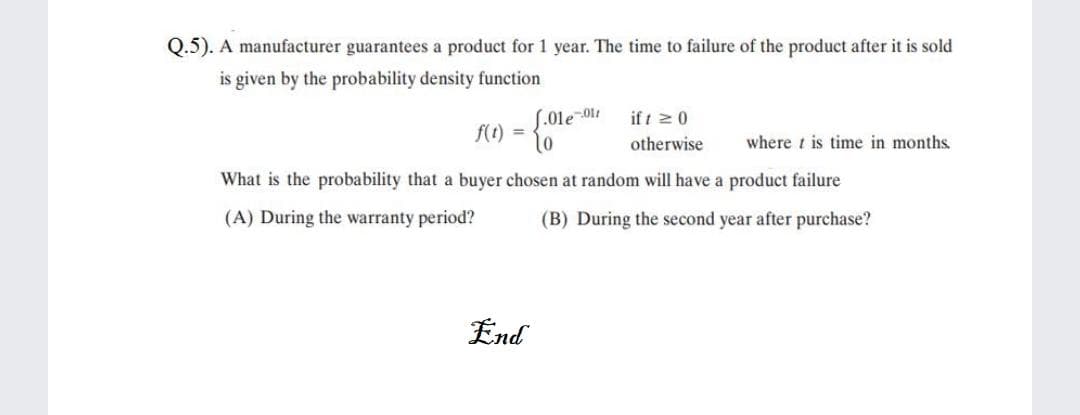). Suppose that 1 years from now, one investment plan will be generating profit at the rate of Pi(t) = 100 + hundred dollars per year, while a second investment will be generating profit at the rate of P2(1) = 220 + 21 hundred dollars per year. (a) For how many years does the rate of profitability of the second investment exceed that of the first? (b) Compute the net excess profit assuming that you invest in the second plan for the time period determined in part (a). (c) Sketch the rate of profitability curves y = P(1) and y = P2(t) and shade the region whose area represents the net excess profit computed in part (b). %3D
). Suppose that 1 years from now, one investment plan will be generating profit at the rate of Pi(t) = 100 + hundred dollars per year, while a second investment will be generating profit at the rate of P2(1) = 220 + 21 hundred dollars per year. (a) For how many years does the rate of profitability of the second investment exceed that of the first? (b) Compute the net excess profit assuming that you invest in the second plan for the time period determined in part (a). (c) Sketch the rate of profitability curves y = P(1) and y = P2(t) and shade the region whose area represents the net excess profit computed in part (b). %3D
Algebra & Trigonometry with Analytic Geometry
13th Edition
ISBN:9781133382119
Author:Swokowski
Publisher:Swokowski
Chapter5: Inverse, Exponential, And Logarithmic Functions
Section: Chapter Questions
Problem 18T
Related questions
Question
Question 1:
Suppose that I years from now, one investment plan will be generating profit at the rate of P₁(t) = 100+ hundred dollars per year, while a second investment will be generating profit at the rate of P2(t) = 220 + 2r hundred dollars per year.
(a) For how many years does the rate of profitability of the second investment exceed that of the first?
(b) Compute the net excess profit assuming that you invest in the second plan for the time period determined in part (a).
(c) Sketch the rate of profitability curves y = P₁(t) and y = P2(t) and shade the region whose area represents the net excess profit computed in part (b).
Question 2:
Answer the questions in Question 1 for two investments with respective rates of profitability P₁(t) = 90e thousand dollars per year and P2 (t) = 140e0.0 thousand dollars per year.
I also need help in question 5 which is in the image attached below.

Transcribed Image Text:Q.1). Suppose that t years from now, one investment plan will be generating profit at the
rate of Pi(t) = 100 + * hundred dollars per year, while a second investment will be
generating profit at the rate of P2(1) = 220 + 2t hundred dollars per year.
(a) For how many years does the rate of profitability of the second investment
exceed that of the first?
(b) Compute the net excess profit assuming that you invest in the second plan for
the time period determined in part (a).
(c) Sketch the rate of profitability curves y = P{(1) and y = P2(1) and shade the
region whose area represents the net excess profit computed in part (b).
Q.2). Answer the questions in Problem 1 for two investments with respective rates of
profitability Pi(1) = 90e0.l' thousand dollars per year and P2(t) = 140e0.07" thousand
dollars per year.

Transcribed Image Text:Q.5). A manufacturer guarantees a product for 1 year. The time to failure of the product after it is sold
is given by the probability density function
S.01e-01t
f(t) =
if t z0
otherwise
where t is time in months.
What is the probability that a buyer chosen at random will have a product failure
(A) During the warranty period?
(B) During the second year after purchase?
End
Expert Solution
This question has been solved!
Explore an expertly crafted, step-by-step solution for a thorough understanding of key concepts.
This is a popular solution!
Trending now
This is a popular solution!
Step by step
Solved in 2 steps with 1 images

Knowledge Booster
Learn more about
Need a deep-dive on the concept behind this application? Look no further. Learn more about this topic, calculus and related others by exploring similar questions and additional content below.Recommended textbooks for you

Algebra & Trigonometry with Analytic Geometry
Algebra
ISBN:
9781133382119
Author:
Swokowski
Publisher:
Cengage

Algebra & Trigonometry with Analytic Geometry
Algebra
ISBN:
9781133382119
Author:
Swokowski
Publisher:
Cengage